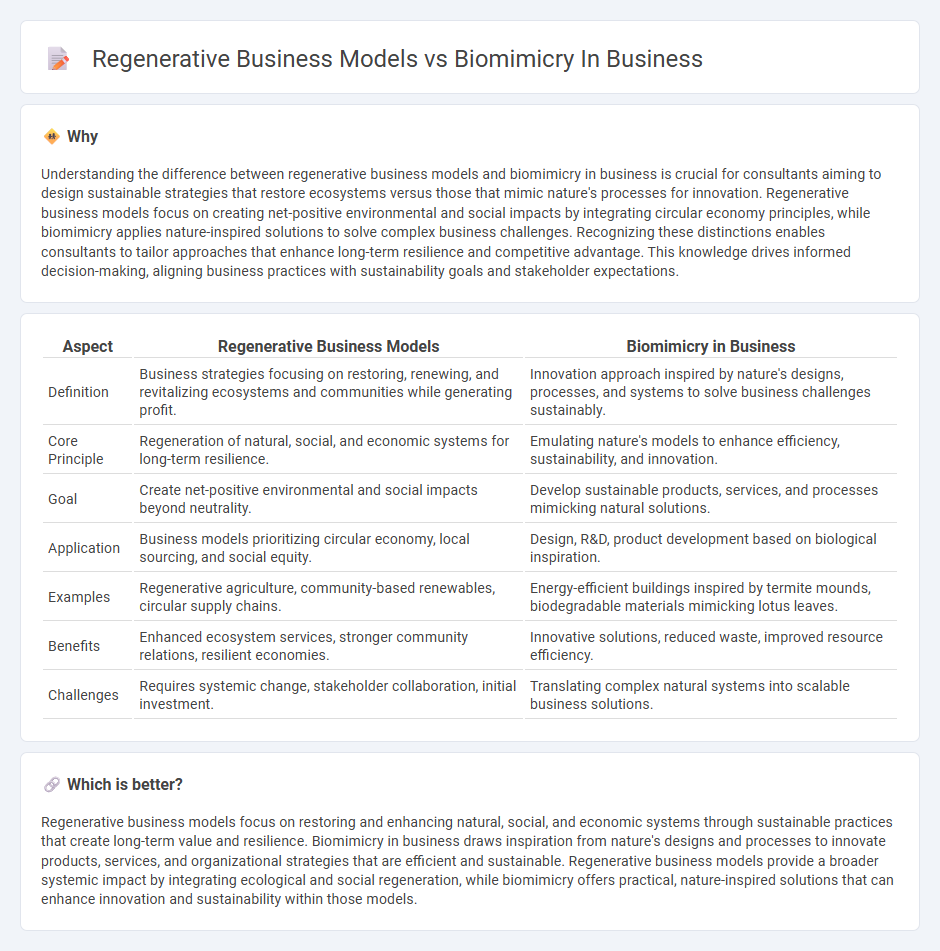
Regenerative business models prioritize restoring and enhancing natural ecosystems while promoting economic growth, contrasting with biomimicry in business that focuses on emulating nature's designs and processes for innovative solutions. These approaches drive sustainability by integrating ecological principles into business strategies, fostering resilience and long-term value creation. Discover more about how regenerative practices and biomimicry are transforming modern commerce.
Why it is important
Understanding the difference between regenerative business models and biomimicry in business is crucial for consultants aiming to design sustainable strategies that restore ecosystems versus those that mimic nature's processes for innovation. Regenerative business models focus on creating net-positive environmental and social impacts by integrating circular economy principles, while biomimicry applies nature-inspired solutions to solve complex business challenges. Recognizing these distinctions enables consultants to tailor approaches that enhance long-term resilience and competitive advantage. This knowledge drives informed decision-making, aligning business practices with sustainability goals and stakeholder expectations.
Comparison Table
| Aspect | Regenerative Business Models | Biomimicry in Business |
|---|---|---|
| Definition | Business strategies focusing on restoring, renewing, and revitalizing ecosystems and communities while generating profit. | Innovation approach inspired by nature's designs, processes, and systems to solve business challenges sustainably. |
| Core Principle | Regeneration of natural, social, and economic systems for long-term resilience. | Emulating nature's models to enhance efficiency, sustainability, and innovation. |
| Goal | Create net-positive environmental and social impacts beyond neutrality. | Develop sustainable products, services, and processes mimicking natural solutions. |
| Application | Business models prioritizing circular economy, local sourcing, and social equity. | Design, R&D, product development based on biological inspiration. |
| Examples | Regenerative agriculture, community-based renewables, circular supply chains. | Energy-efficient buildings inspired by termite mounds, biodegradable materials mimicking lotus leaves. |
| Benefits | Enhanced ecosystem services, stronger community relations, resilient economies. | Innovative solutions, reduced waste, improved resource efficiency. |
| Challenges | Requires systemic change, stakeholder collaboration, initial investment. | Translating complex natural systems into scalable business solutions. |
Which is better?
Regenerative business models focus on restoring and enhancing natural, social, and economic systems through sustainable practices that create long-term value and resilience. Biomimicry in business draws inspiration from nature's designs and processes to innovate products, services, and organizational strategies that are efficient and sustainable. Regenerative business models provide a broader systemic impact by integrating ecological and social regeneration, while biomimicry offers practical, nature-inspired solutions that can enhance innovation and sustainability within those models.
Connection
Regenerative business models and biomimicry in business are connected through their focus on sustainability and circularity by emulating natural ecosystems to create self-sustaining and restorative economic systems. Biomimicry provides design principles inspired by nature that drive regenerative practices, enabling businesses to reduce waste, enhance resource efficiency, and promote biodiversity. This integration fosters innovation in consulting strategies aimed at transforming traditional business models into resilient, adaptive enterprises aligned with environmental regeneration.
Key Terms
Nature-inspired innovation
Biomimicry in business leverages nature-inspired innovation by replicating biological processes and ecosystems to solve complex challenges while promoting sustainability. Regenerative business models go beyond sustainability, aiming to restore and enhance natural systems, creating a positive environmental impact through circularity and resource renewal. Explore how integrating biomimicry with regenerative strategies drives transformative growth and resilience in modern enterprises.
Circular economy
Biomimicry in business leverages nature-inspired designs and processes to create sustainable products and services, enhancing efficiency while reducing environmental impact. Regenerative business models prioritize restoring ecosystems and promoting circular economy principles by minimizing waste, reusing resources, and regenerating natural systems. Discover how integrating biomimicry with regenerative practices drives innovative circular economy solutions for a sustainable future.
Systems thinking
Biomimicry in business applies nature-inspired solutions to innovate sustainably, emphasizing efficient resource use and resilience by mimicking ecosystems. Regenerative business models integrate systems thinking to restore and enhance social, environmental, and economic capital, promoting long-term ecosystem health and community well-being. Explore how these approaches transform industries through holistic, systems-based strategies.
Source and External Links
BIOMIMICRY IN BUSINESS - Biomimicry in business is an innovative approach where companies develop sustainable, efficient solutions inspired by natural systems, enhancing ecological sustainability and meeting consumer demand for eco-friendly products while driving economic success.
How biomimicry can lead to innovative and resilient business solutions - Biomimicry offers a path for startups and large corporations to create disruptive innovation by emulating nature's patterns, which can drive financial growth, reduce costs, and open new markets, distinguishing it from other bio-based approaches by focusing on nature's forms, processes, and systems.
Ten of our Best Biomimicry Examples in Business - Biomimicry in business means designing products and organizations that function like natural systems to solve challenges sustainably, ranging from established innovations to pioneering efforts that tackle complex problems by learning directly from nature's blueprints and ecosystem strategies.
 dowidth.com
dowidth.com